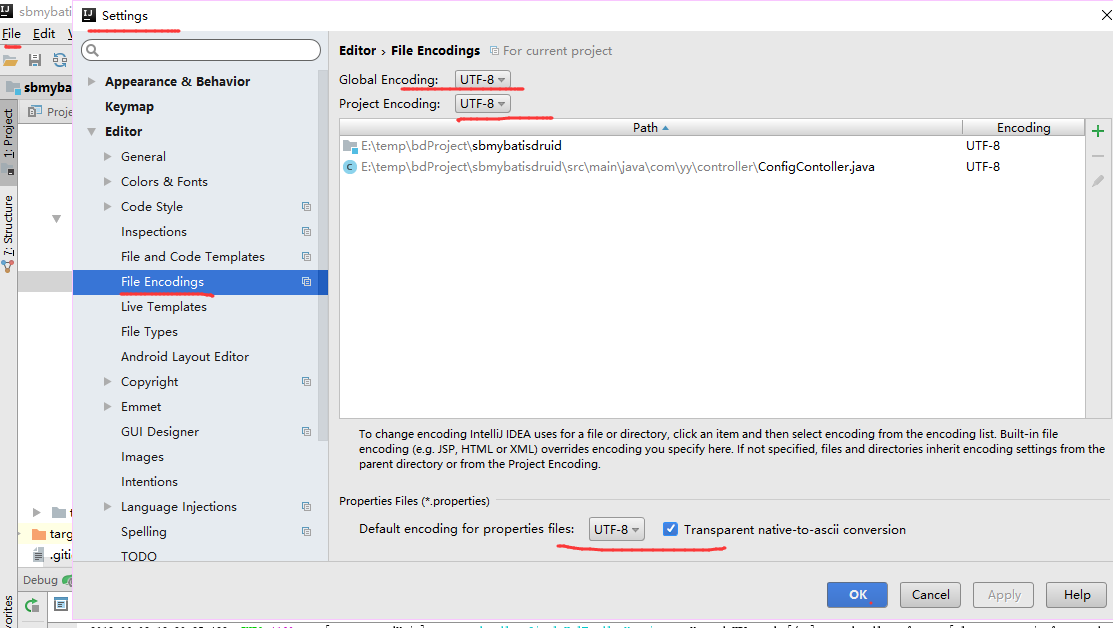本节学习在项目中配置文件配置的方式,一种是通过applicaiton.properties,一种是通过application.yml方式。
一、环境:
IDE:IntelliJ IDEA 2017.1.1
JDK:1.8.0_161
Maven:3.3.9
springboot:2.0.2.RELEASE
二、文件位置
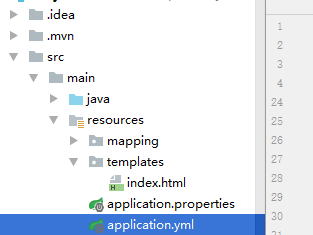
三、application.properties
常见的properties文件配置格式,如下
server.port=8888 # 数据库访问配置 spring.datasource.type=com.alibaba.druid.pool.DruidDataSource spring.datasource.driver-class-name=com.mysql.jdbc.Driver spring.datasource.url=jdbc:mysql://localhost:3306/test?useUnicode=true&characterEncoding=gbk&zeroDateTimeBehavior=convertToNull&useSSL=false spring.datasource.username=root spring.datasource.password=mysql # 下面为连接池的补充设置,应用到上面所有数据源中 spring.datasource.initialSize=5 spring.datasource.minIdle=5 spring.datasource.maxActive=20 # 配置获取连接等待超时的时间 spring.datasource.maxWait=60000 # 配置间隔多久才进行一次检测,检测需要关闭的空闲连接,单位是毫秒 spring.datasource.timeBetweenEvictionRunsMillis=60000 # 配置一个连接在池中最小生存的时间,单位是毫秒 spring.datasource.minEvictableIdleTimeMillis=300000 spring.datasource.validationQuery=SELECT 1 FROM DUAL spring.datasource.testWhileIdle=true spring.datasource.testOnBorrow=false spring.datasource.testOnReturn=false # 配置监控统计拦截的filters,去掉后监控界面sql无法统计,'wall'用于防火墙 spring.datasource.filters=stat,wall,log4j spring.datasource.logSlowSql=true #设置热部署 #开启热部署 spring.devtools.restart.enabled=true #重启范围 spring.devtools.restart.additional-paths=src/main/java #thymeleaf配置 spring.thymeleaf.prefix=classpath:/templates/ spring.thymeleaf.suffix=.html spring.thymeleaf.mode=HTML5 #防止Invalid bound statement (not found) mybatis.mapper-locations= classpath:mapping/*.xml
四.yml文件配置
yml文件的好处,天然的树状结构,一目了然,结构如下
server: port: 8888 #端口 spring: datasource: #数据源配置 type: com.alibaba.druid.pool.DruidDataSource driver-class-name: com.mysql.jdbc.Driver url: jdbc:mysql://localhost:3306/test?useUnicode=true&characterEncoding=gbk&zeroDateTimeBehavior=convertToNull&useSSL=false username: root password: mysql initialSize: 5 #连接池配置 minIdle: 5 maxActive: 20 maxWait: 60000 #连接等待超时时间 timeBetweenEvictionRunsMillis: 60000 #配置隔多久进行一次检测(检测可以关闭的空闲连接) minEvictableIdleTimeMillis: 300000 #配置连接在池中的最小生存时间 validationQuery: SELECT 1 FROM DUAL testWhileIdle: true testOnBorrow: false testOnReturn: false poolPreparedStatements: true # 打开PSCache,并且指定每个连接上PSCache的大小 maxPoolPreparedStatementPerConnectionSize: 20 filters: stat,wall,log4j # 配置监控统计拦截的filters,去掉后监控界面sql无法统计,'wall'用于防火墙 logSlowSql: true devtools: #设置热部署 restart: enabled: true #开启热部署 additional-paths: src/main/java #重启范围 thymeleaf: #thymeleaf prefix: classpath:/templates suffix: .html mode: HTML5 encoding: UTF-8 servlet: content-type: text/html cache: false resources: chain: strategy: content: enabled: true paths: /** mybatis: #Invalid bound statement (not found) mapper-locations: classpath:mapping/*.xml
yml格式在编写过程中有几点需要注意:
- 大小写敏感
- 使用缩进表示层级关系
- 缩进时不允许使用Tab键,只允许使用空格
- 缩进的空格数目不重要,只要相同层级的元素左侧对齐即可
- 每个散列项冒号和值之间至少有一个空格,如 enabled: true
五、多环境配置应用配置
在实际项目应用中,开发、测试、生产几个环境中的配置是不一样的,为了区分不同环境配置,方便修改部署,可以在项目中针对不同环境配置不同的参数,在系统部署时根据具体情况快速选择加载的相应的配置。
1.application.properties多环境配置
在项目中,分别针对开发、生产及测试添加application-dev.properties、application-prod.properties、application-test.properties三个配置文件,如下图。各properties文件内容同上application.properties,分别设置开发、生产、测试配置文件中的端口8887、8888、8889,
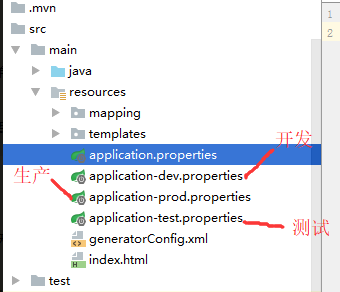
修改application.properties内容为
## 开发/测试/生产环境分别对应dev/test/prod,可以自由定义
spring.profiles.active=dev
此处配置激活配置开发配置文件,启动项目,可以看到项目访问端口为开发端口8887。
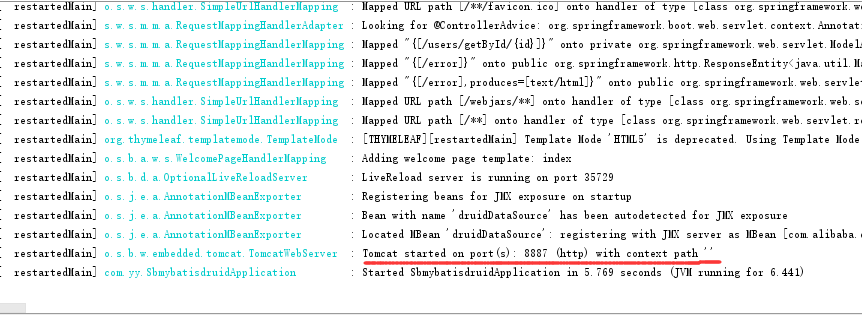
可以测试,修改application.properites内容为pring.profiles.active=prod或者pring.profiles.active=test,分别启动,则可以看到项目端口变为8888、8889。
通过上面配置,可以针对不同环境在各自的配置文件中设置相应的配置参数,在项目部署时只要在主application.properites中简单的修改激活哪一个文件即可,而不用修改具体的文件内容。
1.application.yml多环境配置
yml配置文件设置与properties配置文件设置类似,分别添加application-dev.yml、application-prod.yml、application-test.yml,修改文件中的项目启动端口为8890、8891、8892。
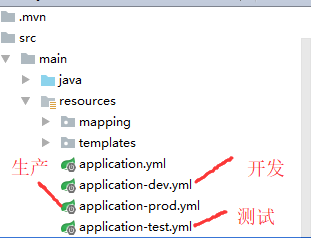
主配置文件application.yml内容为
spring:
profiles:
active: dev
启动项目,查日志

同上,修改application.yml,启动prod、test,启动端口相应的变为8891、8892
六、yml与properties混用
在一个项目中如果即配置了properties也配置了yml,则优先使用properties。
在上面示例中继续测试,在项目中通过properties、yml同时配置了开发、生产及测试。
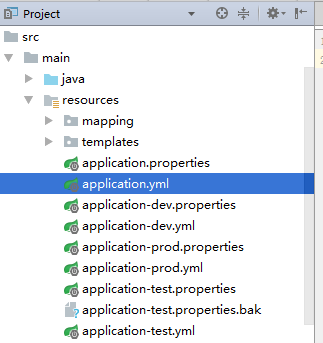
各文件配置内容见上。
设置application.properties  设置application.yml
设置application.yml 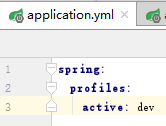
启动项目,查看日志

项目使用开发配置文档中配置的端口8887。即项目默认使用application.properties,激活application-dev.properties。
另一种情况,其他不变,在上面配置文件列表中删除application.properties,项目启动会自动使用application.yml作为主配置。
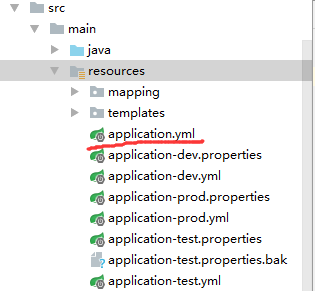
application.yml文件内容不变,如下
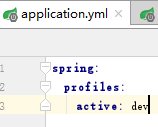
即激活开发配置文件。在配置文件列表中有application-dev.properties(端口8887),application-dev.yml(端口8890),项目启动激活哪一个呢?
启动项目,查看日志如下
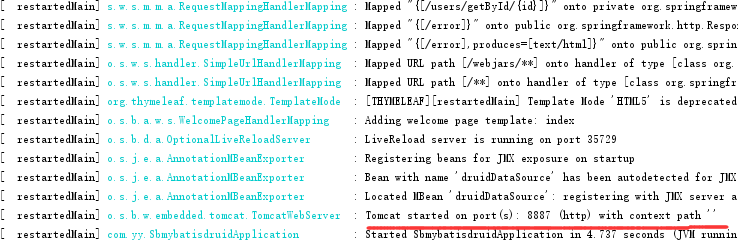
有日志可以看出,激活的是application-dev.properties。由此看出,在多个配置文件中,如果同时存在.properties、.yml配置文件,项目优先使用.properties文件内容作为项目配置参数。
七. 在项目中如何读取和使用配置文件(.properties或yml)中的配置信息?
自定义配置文件myconfig.properties,要读取的配置文件中的信息如下
#自定义配置信息
test.info.url=http://www.baidu.com
test.info.title=百度
test.info.description=要使用的搜索引擎
test.info.other=我是百度旗下的搜索产品
结果展示页面
templates/config.html
<!DOCTYPE html> <html lang="en" xmlns:th="http://www.w3.org/1999/xhtml"> <head> <meta charset="UTF-8"> <title>Title</title> </head> <body> <h1>spring boot</h1> 读取配置信息:<div th:text="${url}">地址</div> <div th:text="${title}">标题</div> <div th:text="${description}">描述</div> <div th:text="${other}">其他</div> </body> </html>
1.@ConfigurationProperties方式
自定义配置类:PropertiesConfig.java
package com.yy.entity; import org.springframework.boot.context.properties.ConfigurationProperties; import org.springframework.context.annotation.PropertySource; import org.springframework.stereotype.Component; /** * Created by Administrator on 2018-06-08. */ @Component @ConfigurationProperties(prefix = "test.info") //默认读取application.properties //@PropertySource(value="application.properties") @PropertySource(value="myconfig.properties") public class PropertiesConfig { public String url; public String title; public String description; public String other; public String getUrl() { return url; } public void setUrl(String url) { this.url = url; } public String getTitle() { return title; } public void setTitle(String title) { this.title = title; } public String getDescription() { return description; } public void setDescription(String description) { this.description = description; } public String getOther() { return other; } public void setOther(String other) { this.other = other; } }
自定义ConfigContoller.java,读取配置信息
package com.yy.controller; import com.mysql.fabric.xmlrpc.Client; import com.yy.entity.PropertiesConfig; import org.springframework.beans.factory.annotation.Autowired; import org.springframework.stereotype.Controller; import org.springframework.web.bind.annotation.RequestMapping; import org.springframework.web.servlet.ModelAndView; import java.util.HashMap; import java.util.Map; import java.util.Properties; import java.util.zip.InflaterInputStream; /** * Created by Administrator on 2018-06-08. */ @Controller @RequestMapping("/config") public class ConfigContoller { @Autowired private PropertiesConfig propertiesConfig; @RequestMapping("/getInfo") private ModelAndView getConfigInfo() { ModelAndView mv=new ModelAndView("/config"); Map<String,Object> map=new HashMap<String,Object>(); mv.addObject("url",propertiesConfig.getUrl()); mv.addObject("title",propertiesConfig.getTitle()); mv.addObject("description",propertiesConfig.getDescription()); mv.addObject("other",propertiesConfig.getOther()); return mv; } }
运行结果
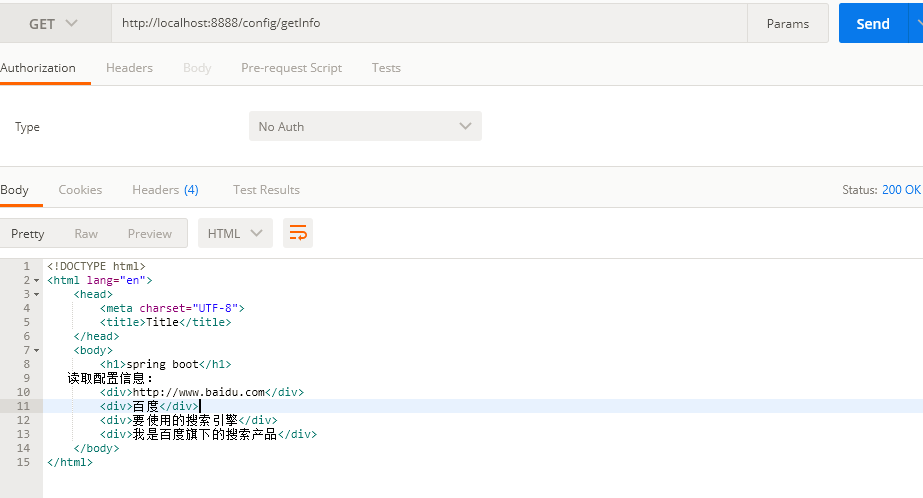
(2)使用@Value注解方式
其他同上,重新编写一个controller,如下
@Controller @RequestMapping("/config") public class ConfigContoller1 { @Value("${test.info.url}") private String url; @Value("${test.info.title}") private String title; @Value("${test.info.description}") private String description; @Value("${test.info.other}") private String other; @RequestMapping("/getValueInfo") private ModelAndView getConfigInfo() { ModelAndView mv=new ModelAndView("/config"); mv.addObject("url",url); mv.addObject("title",title); mv.addObject("description",description); mv.addObject("other",other); return mv; } }
测试结果
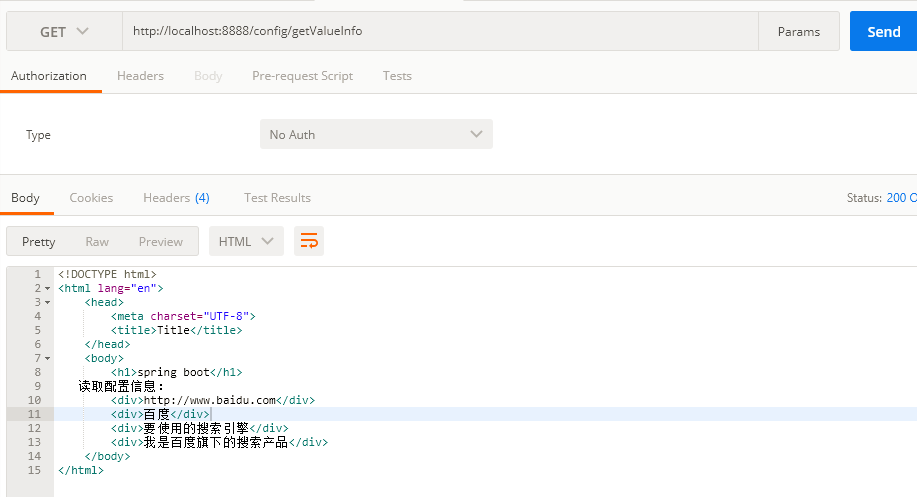
(3)使用Environment
package com.yy.controller; import org.springframework.beans.factory.annotation.Autowired; import org.springframework.beans.factory.annotation.Value; import org.springframework.context.annotation.PropertySource; import org.springframework.core.env.Environment; import org.springframework.stereotype.Controller; import org.springframework.web.bind.annotation.RequestMapping; import org.springframework.web.servlet.ModelAndView; import java.util.HashMap; import java.util.Map; /** * Created by Administrator on 2018-06-08. */ @Controller @RequestMapping("/config") public class ConfigContoller2 { @Autowired private Environment evn; @RequestMapping("/getEnvInfo") private ModelAndView getConfigInfo() { ModelAndView mv=new ModelAndView("/config"); mv.addObject("url",evn.getProperty("test.info.url")); mv.addObject("title",evn.getProperty("test.info.title")); mv.addObject("description",evn.getProperty("test.info.description")); mv.addObject("other",evn.getProperty("test.info.other")); return mv; } }
启动项目,查看测试结果
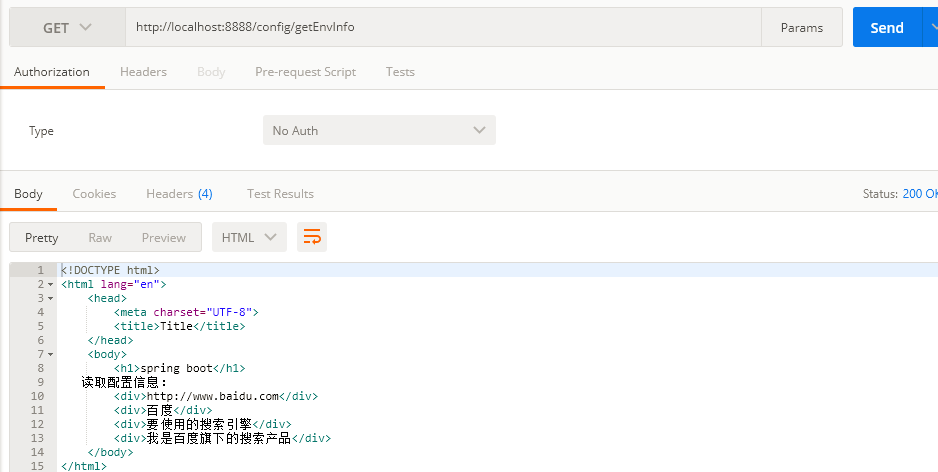
八.关于读取配置参数properties中文乱码
